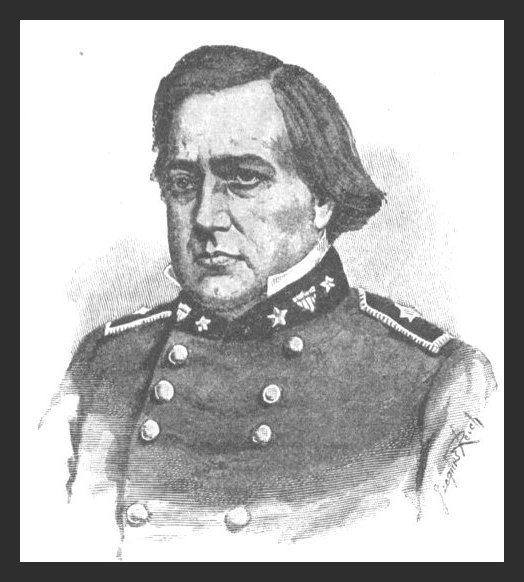Disclaimer
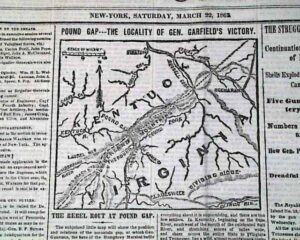
Here at Kentucky Tennessee Living, we strive to keep this site nonpolitical in nature. All historic events posted that changed the lives of future generations and have helped to give miners a voice in their working and living conditions. As well as we remember those who fought on both sides of the Civil War. All events posted are for the benefit of remembering who we are as the American Appalachian people.
The Civil War
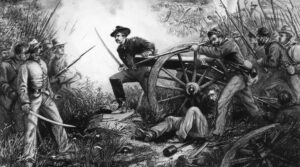
Between the years of April 12, 1861, and May 9, 1865, the War Between the States raged. The peace of the Appalachian Mountains was broken as brother took up arms against his brother. Several battles were won and lost the area of Letcher County and we will try to cover as many of them as possible.
Who was General Humphrey Marshall?
Humphrey Marshall was born on July 13, 1812 in Frankfort, Kentucky to John Jay and Anna Birney Marshall, Humphrey. Humphrey’s father John Jay was a legislator, judge, and law reporter.
Relations
Humphrey was first cousins to William and David Birney who were both served as generals on the Union side of the War. Their father James G. Birney, Humphrey’s uncle was a well known abolitionist. He had another cousin that served as the Lieutenant Governor of Michigan, and later Minister to the Netherlands whose name was James M. Birney.
His grandfather’s name was also Humphrey served as a United States Senator from the state of Kentucky. The older Humphrey was the first cousin to Chief Justice John Marshall.
Education
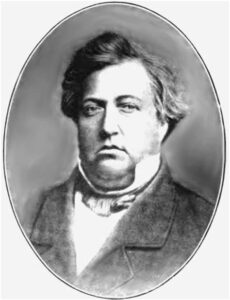
Humphrey the younger was a 1832 West Point graduate from the United States Military Academy in New York. He would graduate as the 42nd in his graduating class. He served as Brevet 2nd Lieutenant with the mounted rangers and dragoons. Marshall would fight in the Black Hawk War during this time. After this conflict in April of 1833, Marshall resigned from the Army to study law.
In 1833, the State of Kentucky admitted Marshall into the bar and he practiced law in Frankfort, Kentucky. Two years later in 1835, Marshall would move to Louisville, Kentucky.
Kentucky Militia and the Mexican-American War
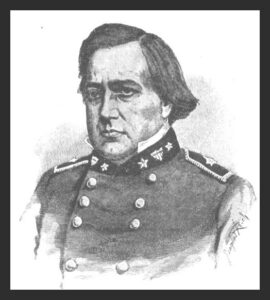
In 1836, Humphrey Marshall joined a militia and became a captain. During this time Marshall and a company of volunteers marched to defend Texas and the frontier against the Native Americans. His force disbanded however when General Sam Houston had a victory at San Jacinta.
By 1838, Marshall was a major. In 1841, he became a lieutenant colonel. In 1846, Marshall became a colonel of the 1st Kentucky Cavalry during the Mexican-American War. He fought in the Battle of Buenos Vista with Zachary Taylor’s Army of Occupation.
Congressman
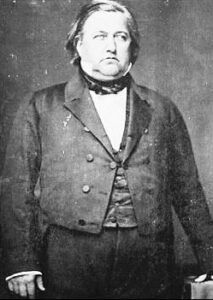
Marshall returned home after the Mexican-American War and became a farmer in Henry County, Kentucky On March 4, 1849, Marshall was elected from the Kentucky’s 7th District as a Whig to the 31st and 32nd Congresses. During his time in the Congress, he supported Henry Clay’s Compromise of 1850. He resigned from his Congress position on August 4, 1852.
From 1852-1854 Marshall was appointed as the United States diplomatic commissioner to China. When this term was over, he returned to the state of Kentucky where he was again elected to the 34th and 35th Congresses. Even though he was renominated for a fifth term in office, he turned the offer down and refused to run.
In 1856, he became a member of the American Political Party of New York City. And he was instrumental in removing all secrecy in the political organization.
Civil War Battles
Marshall was known for being moderate in his political views. He supported John C. Breckenridge for President in 1860. He also advocated and worked for the state of Kentucky to remain neutral. This effort failed when Union Troops occupied the state of Kentucky. Marshall felt that this was coercion.
Enlisting with the rank of brigadier general, Marshall joined the confederacy and aided in recruitment. He was stationed in West Virginia but saw very little combat.
Pound Gap and The Battle of Middle Creek
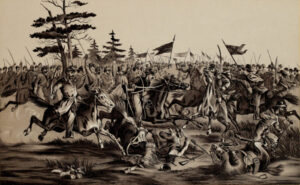
In January 1862, General Humphrey Marshall and his troops were stationed in Paintsville, Kentucky. There he would be confronted in battle by General and future President James A. Garfield. The fighting did not go well as Garfield’s Federal cavalry chased off the cavalry from Marshall’s troops to the forks of Middle Creek, two miles from Prestonsburg, Kentucky. On January 9th, the two armies met again and Marshall again withdrew his troops after a day of fighting.
General Humphrey Marshall had his troops vacate their trenches at Hager Hill and marched his four regiments up the Prestonsburg Road to the mouth of Abbot Creek which intersected with the Pound Gap road at that point. Marshall used this point to station his troops.
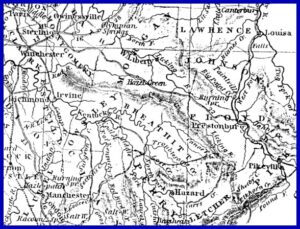
Because Garfield was pursuing him from Paintsville, Marshall had received intelligence that Cranor’s 40th Ohio was moving east from Licking Station to reinforce Garfield. He was in a perfect position to intercept either of these forces before they had the chance to combine against him.
This area also afforded Marshall a route out of the area if he won or lost the battle and had to do a hasty retreat. As it turned out, it was a retreat. He retreated his forces through modern-day Goodloe and Pyramid, over Brushy Mountain, and down Brush Creek to Hueysville. He then established a new camp at the Joseph Gearheart Farm for a week. According to tradition one unnamed Confederate Soldier died and was buried at the Gearheart Cemetery. While other soldiers burned fence posts to keep warm. Marshall then moved his troops to the Johnny Martin farm for rest and a warm welcome.
Princeton Court House and First Resignation
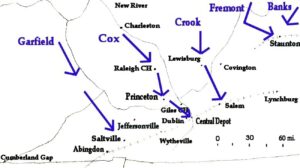
Marshall was able to obtain a victory at the Princeton Court House battle. This would be a minor battle in the war and was fought on May 15-17, 1862 in Mercer County, Virginia. The battle would see the win for Marshall against brigadier general Jacob Dolson Cox, who was trying to threaten the East Tennessee and Virginia railroads.
Even though Marshall had a victory in this battle, he became frustrated because he was not allowed to have a bigger assignment in the war. In June 1862, Marshall briefly handed over his resignation.
Return and Second Resignation
In the fall of 1862, Marshall returned to battle and was part of the Braxton Bragg’s Kentucky operations. After a short time in June 1863, Marshall then resigned his commission again and moved to Richmond, Virginia where he practiced law.
Second Confederate Congress and Collapse of the Confederacy

While in Richmond, Marshall was elected to the Second Confederate Congress in November of 1863. He would represent the Kentucky’s 8th District. When the Confederacy collapsed and the Second Confederate Congress was disbanded, Marshall briefly fled to Texas for safety.
Citizenship Restored
When the Civil War was finally over, Marshall moved to New Orleans, Louisiana. While there, President Andrew Jackson restored Marshall to a citizen of the United States in December 1867.
Marshall then returned to Louisville, Kentucky and began to practice law again. There he would stay until his death on March 28, 1872. He would be buried at a Frankfort Cemetery in Franklin County, Kentucky.
Sources:
Pound Gap Civil War Memorial
http://kytnliving.com/poundgapcivilwarmemorial
The Battle of Pound Gap
March 16, 1862
Facebook Post March 16, 2016 Kentucky Tennessee Living
Pound Gap ~~ there is more than meets the eye.
February 10, 2021
Facebook Post Kentucky Tennessee Living
Humphrey Marshall
https://www.findagrave.com/memorial/8930/humphrey-marshall
Humphrey Marshall (general)
https://en.wikipedia.org/wiki/Humphrey_Marshall_(general)
Humphrey Marshall (general)
https://military-history.fandom.com/wiki/Humphrey_Marshall_(general)
Brig. General Humphrey Marshall (CSA), U.S. and Confederate Congressman
https://www.geni.com/people/Brig-General-Humphrey-Marshall-CSA-U-S-and-Confederate-Congressman/6000000012302765508
Copyright and Other Information
All photos are in the public domain unless otherwise noted. This includes photos dated before 1923. All other photos are used with permission or under the education fair use statute of the US copyright law.
Copyright 2022 Kentucky Tennessee Living
kytnliving.com/copyright-2/
Social Media Pages
For more about us, you can visit our Facebook page:
https://www.facebook.com/kytnliving
Our Twitter page:
https://www.twitter.com/KYTNLiving
Our YouTube Channel:
https://www.youtube.com/kytnliving
When we forget our past and who we are as a people, then we become who “they” say we are. ~~ David Sergent
I have attended the University of Kentucky. I have an Associates Degree from Hazard Community College and Technical School. I have also attended the University of Pikeville. I have taken several classes in Journalism as well as in the Appalachian History, Literature, and Sociology during my time at those schools.
I was born in Florida and grew up in Burdine, Kentucky. I have been married to David W. Sergent since May 4, 2013. I have two children and four grandchildren from a previous marriage. I currently live in Tennessee but my hope is to one day come back home to live in the beautiful mountains once more.


